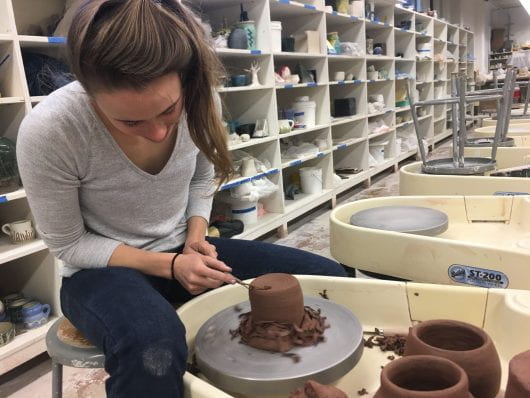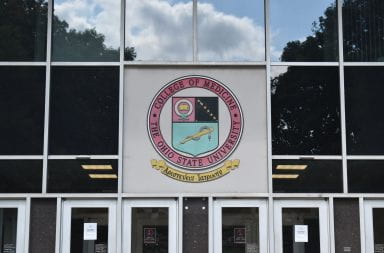
Casey Mitchell, a fourth-year in marketing, works in the basement of Hopkins Hall while using clay and Ohio State’s resources to create heartfelt Christmas presents for family members. Credit: Taylor Smith | Lantern Reporter
Descending the steps to the basement of Hopkins Hall, visitors are immediately greeted with the smell of clay and a sign that prominently displays the words “Dante’s Inferno.”
A warm, yellow light bounces off glossy creations in glass cases, vibrantly accenting the cream-colored brick walls. With a dull hum filling the basement, narrow windows offer glimpses into organized, yet chaotic, classrooms. Hundreds of unfinished projects line shelves on the outer walls while students hunch over messy, newspaper- and clay-covered tables.
Here, Ohio State’s graduate ceramics program has earned its spot as No. 4 in the nation, according to U.S. News & World Report in 2016.
Employing only one tenured faculty member, the close-knit ceramics program within Ohio State’s fine arts department currently has seven graduate students working toward their master’s degree in fine arts with a specialization in ceramics.
Ohio State has been fine-tuning its graduate ceramics program for almost 100 years, Steven Thurston, area coordinator and tenure-track faculty, said. The program, which originated in 1926, is the second oldest in the nation, Thurston said.
He added that Ohio State’s ceramics program remains top-notch because of how students are educated.
“I challenge them to find their own voice,” Thurston said.
The program does not aim to cultivate any specific research or style from the students but instead allows them to grow a skill set. Students can use the skills to conduct their own research and challenge the status quo when it comes to ceramic practices, Thurston said.
Corey Mahoney, visiting artist and lecturer, came to Ohio State this year after receiving his Master of Fine Arts from Alfred University. Although his alma mater has the top-rated ceramics program in the country, Mahoney said the resources and support offered at Ohio State hold up to Alfred University.
He said Ohio State’s program provides students with the freedom to explore less traditional techniques.
“I am always trying to provide more questions for students to get them to tap into their own creativity,” Mahoney said.
The program, however, provides more than just clay for students to experiment with in their ceramic work. Materials are brought in by the truckload, offering a variety of different colors and textures, Maxwell Holden, a third-year in the program, said.
Karen Tharp, a second-year graduate student, said she is currently working with clay and metal, two different materials she found to act similarly when heated to a specific temperature. She said the technique is not commonly practiced by artists.
“I’m kind of intertwining them in certain ways and firing them together in the kiln to see our material reaction take place,” Tharp said.
Tharp said the legacy of Ohio State alumni allows for artists in the program to connect with Ohio-based companies that provide materials necessary for experimentation, as well as field-trip destinations. Although she said typical objects like bricks are not common when studying ceramics, seeing how bricks were made at a local plant broadened her mind to the possibilities within the area of ceramics.
Thurston said another aspect important to the program’s success is the amount of space available. Taking up the entire basement of Hopkins Hall, the ceramics program has 10 electric kilns and eight gas kilns, which are ovens that reach extremely high temperatures to fire ceramics, Holden said.
Taking full advantage of the kilns available, Holden said his pieces must sometimes be fired three and four times. This process often takes up to a month, so Holden said he usually has multiple projects going at once.
Students are able to work with industrial productions without the worry of space, allowing for even more innovative practices, Thurston said.
Thurston said the program challenges students to invest themselves in the possibilities the world of ceramics provides.
“Clay doesn’t become ceramics until it’s fired, but what you do between those stages is endless in its variables,” Thurston said.
Mahoney said he often has his students repeat projects or experiments time and time again, focusing on each individual step of the process. He said by the 100th time of working with an object, the way the student thinks of the object has changed completely, giving way to a whole new perspective.
Ohio State graduate students have the opportunity to forego the financial burden of a master’s program by teaching undergraduate classes. Those who take on a graduate teaching assistantship receive a stipend and tuition waiver, Thurston said.
Thurston said he would guess more than 90 percent of the program’s graduates are still producing in the field.
“I think it’s a program that will outlive me,” Thurston said.


